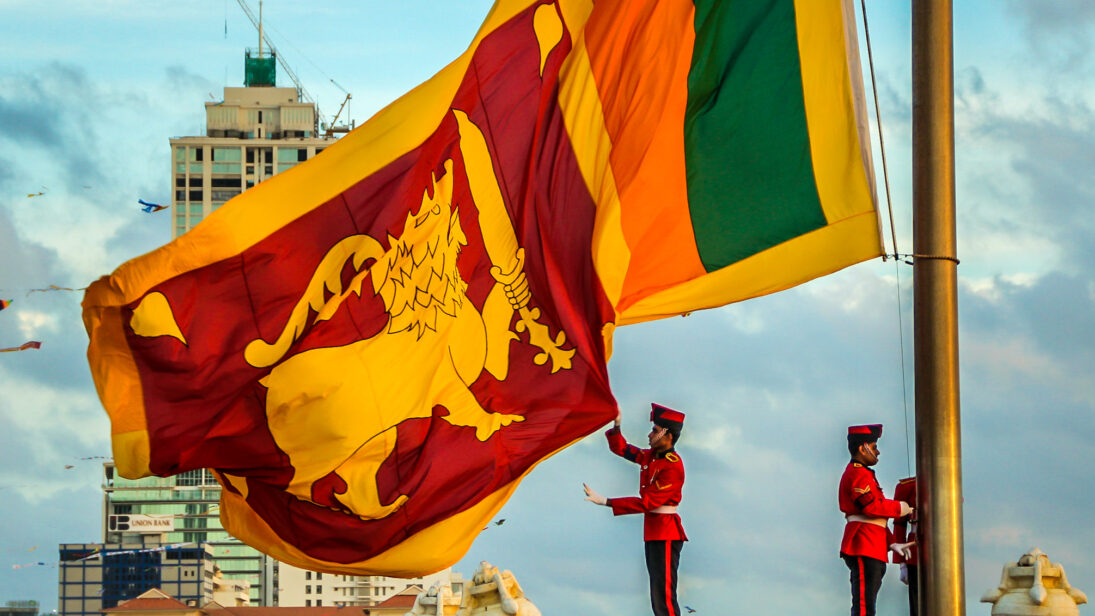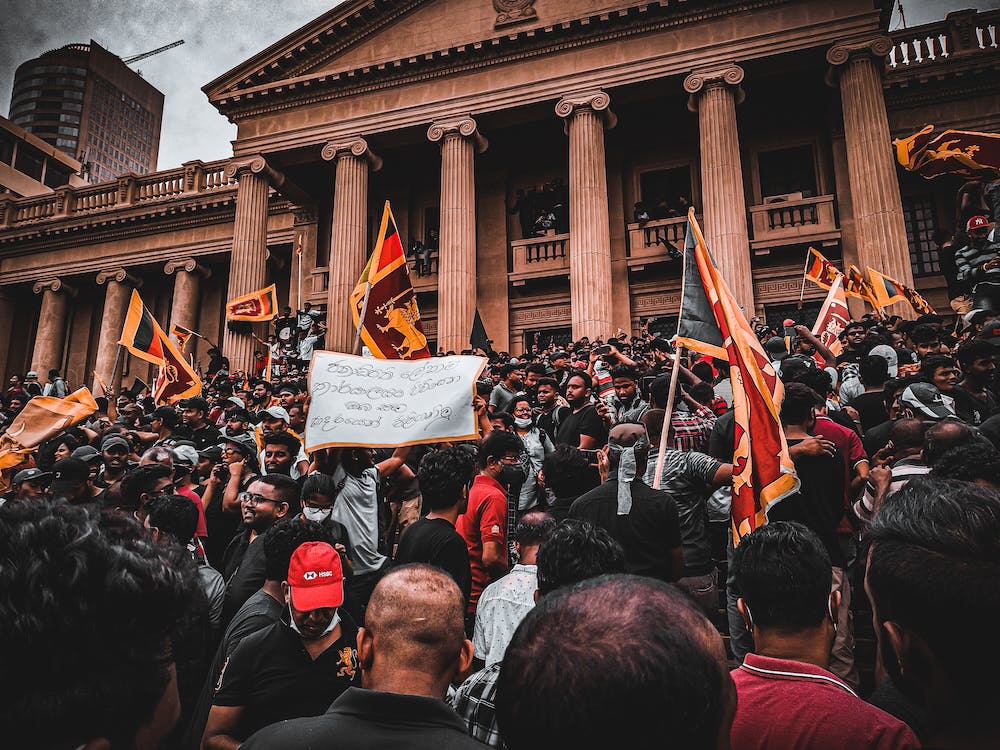
by Isha Gupta : 2023 was a transitional year for Sri Lanka as it continued to recover from its worst economic crisis since independence. While the previous year’s mass Aragalaya (“struggle” in Sinhalese) protests in response to the crisis kicked out the previous government, many economic and political realities remained the same. Sri Lanka continued to attempt to balance relationships with regional heavyweights China and India amid intensified geopolitical competition in its neighborhood. At home, a newly installed government led by Ranil Wickremesinghe resorted to familiar authoritarian and anti-democratic practices to quell dissent, especially against minority populations. With presidential elections set to take place in 2024, Sri Lanka is at an important crossroads in its economic and political future. It must decide between implementing politically convenient band-aid solutions or resolving the structural problems that predate its crisis.
Economic Recovery: The Much-Awaited IMF Bailout
After the height of Sri Lanka’s economic crisis in 2022, severe food shortages, queues for fuel, and power cuts have mostly ended, especially in urban areas. Though the new government has taken some immediate steps to tackle the causes of the financial collapse – including reversing the previous administration’s big tax cuts and aiding farmers whose crops were severely decimated by a previous organic farming ban – the change has been slow. As Dr. Nishan De Mel argues, resolving the country’s economic woes is contingent on tackling a more fundamental governance problem stemming from rampant incompetence and corruption in policymaking.
In March 2023, the IMF board approved Sri Lanka’s request for a USD $2.9 billion bailout and four-year program to restore the island’s economic stability. In the months since then, the Sri Lankan government has embarked on a few measures to fulfill the IMF program. Sri Lanka’s Central Bank released a domestic debt-restructuring plan at the end of June, and the island reached an “agreement in principle” with the Paris Club – including India and Japan – and struck a separate deal with China in October 2023 to cover its external debt. Despite Verité Research’s IMF tracker reporting that Sri Lanka met only 41 out of 73 commitments by the end of October, all these actions paved the way for the IMF to deem that Sri Lanka had made “satisfactory” progress and release the second tranche of USD $337 million to Sri Lanka on December 12.
Many signs suggest that these existing efforts do not go far enough. For instance, the domestic debt-restructuring plan passed by Parliament mostly cuts the retirement savings of private sector workers, which critics claimed spared the banking sector, international creditors, and individual domestic creditors from bearing their share of the economic burden. Moreover, wages have not kept up with rising costs, contributing to heightened poverty and food insecurity. Combined with the government’s efforts to raise revenue through increasing electricity bills and income taxes, Sri Lanka’s economic recovery has been felt unevenly by different segments of its population, eliciting protests and even union strikes.
Political Stagnation Despite Change in Incumbency
After former President Gotabaya Rajapaksa resigned during the height of the Aragalaya protests in July 2022, former six-time prime minister Ranil Wickremesinghe was appointed by Parliament as his replacement. After coming to power without a direct popular mandate, President Wickremesinghe’s primary concern was retaining power long enough to enact necessary economic reforms while proving his legitimacy ahead of presidential elections in 2024. However, in doing so, he has avoided running for elections altogether in 2023. For instance, the government indefinitely postponed local elections that were scheduled for early March 2024 due to the “lack of funds,” eliciting protests from opposition parties and civil society alike.
Despite a change in government, not much has improved for Sri Lanka’s political landscape and human rights track record. Dozens of protestors arrested during the summer of 2022 for “committing terrorist acts” during the Aragalaya remained behind bars well into 2023. Those demonstrating for their release in subsequent months have also met with harsh measures from security forces, including tear gas and water cannons. Many of those arrested were charged under Sri Lanka’s longstanding Prevention Against Terrorism Act (PTA), which enables the government to detain citizens for prolonged periods of time without due process.
The new government has attempted to respond to international pressure concerning human rights violations during Sri Lanka’s civil war by establishing a National Unity and Reconciliation Commission but that is currently in its interim phase. However, as the Sri Lankan military continues to occupy land in the North and East that formerly belonged to Tamils and Muslims, public perceptions of the Commission’s potential to enact meaningful change remains skeptical.
In March 2023, the government published the Anti-Terrorism Act (ATA) – presented as a new and improved version of the PTA, since it empowers magistrates to check if suspects imprisoned by the government have suffered torture or abuse. However, the ATA still gave the president, police, and military broad powers to detain people without evidence, criminalize speech without clearly defined parameters, and arbitrarily ban mass gatherings and organizations, eliciting outcry from segments of Sri Lankan society – from Tamil parties in the North and East and civil society organizations to trade unions and legal experts. Simultaneously, the government’s proposed Online Safety Bill also received criticism for curtailing free speech online, proving that kicking out Sri Lanka’s political old guard has not necessarily translated into long-term reforms to governance and human rights.
Geopolitical Balancing
In the aftermath of the economic crisis last year, Sri Lanka was careful to balance its geopolitical relationships in 2023, especially as it negotiated its external debt. When the Rajapaksas were in power, many analysts accused Sri Lanka of “pivoting” toward China, as it participated in the Belt and Road Initiative through the Hambantota Port and the Colombo Port City project. The Wickremesinghe government, on the other hand, has been strategic about its engagements, leveraging the six-time prime minister’s Western-oriented image to court India and the West while quietly continuing economic engagement with China.
During President Wickremesinghe’s tenure in 2023, Sri Lanka stepped back up its relationship with India after the latter provided financial assistance to the island in the immediate aftermath of the crisis. For instance, in his July 2023 visit with Prime Minister Narendra Modi, President Wickremesinghe announced a new Standard Operating Procedure for foreign research and military vessels docking in Sri Lanka’s ports to assuage concerns following the Chinese Yuan Wang 5’s visit to Hambantota Port in August 2022. The government doubled down on responding to India’s concerns by imposing a one-year pause to any foreign research vessels docking in Sri Lanka’s ports.
The visit also produced increased momentum on strengthening energy and technology cooperation and improving land connectivity on the Palk Strait. Accordingly, the two leaders inaugurated renewed ferry services between Tamil Nadu and Jaffna in October 2023. India has also closely coordinated with the United States on its investments in Sri Lanka, with the U.S. International Development Finance Cooperation announcing that it would lend USD $533 million to an Adani-owned deep-water shipping container terminal at the Port of Colombo in November 2023.
However, the China-Sri Lanka relationship has showed no signs of slowing down, despite widespread criticism of China’s outsized involvement in Sri Lanka’s economic troubles. Unlike the United States’ and India’s approach to investing in Sri Lankan infrastructure to respond to the economic crisis, China has prioritized direct donations and used more soft power to restore its tarnished reputation from the perceived negative effects of its BRI program. Moreover, China still has multiple active investment projects on the island, including the Port City Colombo Project that opened in February 2023.
After China’s unconditional support for Sri Lanka during years of UN investigations into human rights violations during the civil war, it has also continued its political sway on the island even with a change in government. President Wickremesinghe decried AUKUS – which would increase security cooperation between the U.S., Australia, and the UK – at the UN General Assembly as a “mistake” and attended the BRI summit in October. The Wickremesinghe administration has attempted to be smarter than its predecessors about navigating the geopolitical competition of the Indian Ocean, but it is unclear if Colombo has carved out a long-term strategy to ensure that powers do not view their relationships with Sri Lanka as a zero-sum game.
The Road Ahead
2024 will be a critical year for Sri Lanka, as it faces a potential new government amid its continued path toward a full economic recovery. The Wickremesinghe government is banking on reelection to deliver on some of its promises, such as further economic reforms to fulfill the IMF mandate and seeing the interim National Unity and Reconciliation Commission to fruition.
However, Wickremesinghe relies on opposition support to maintain power as president, as he was only appointed through Parliament without a popular mandate from the Sri Lankan electorate. Nonetheless, polling from August 2023 indicates that Wickremesinghe is still trailing behind opposition politicians like the Janatha Vimukthi Peramuna’s Anura Kumara Dissanayake and the Samagi Jana Balawegaya’s Sajith Premadasa. As the government and opposition gear up for an election year, there are concerns that the government’s commitment to enact unpopular economic reforms might crumble amid intensified politicization with the upcoming campaign cycle.
If 2023 was the year that Sri Lanka scraped by with short-term responses from an interim government looking to solidify support, 2024 will be a year where Sri Lanka makes decisions that impact its long-term trajectory. The question that looms large is whether a potentially new government will resort to politically convenient solutions to retain power or make decisions that allow Sri Lanka to resolve underlying fault lines in governance, such as addressing civil war legacies and exacerbated geopolitical competition.

